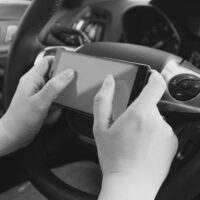New Study Reveals Surprising New Distracted Driving Activities That Could Lead to Accidents

According to the National Highway Traffic Safety Administration, almost 3,000 people died from distracted driving in 2018 alone, and 90 percent of these accidents could be traced back to human error, including distraction and inattentiveness. And yet, their cell phones aren’t the only things distracting them anymore: According to a new survey, drivers in the United States admitted to some very surprising (and arguably disturbing) distracted driving behaviors; all of which have the potential to lead to serious auto accidents. In addition to using their cell phones while driving, these activities, for example, included putting in contact lenses, engaging in sexual activity, and changing diapers; amongst others.
Specifically, according to the survey, the most common distracted driving behaviors (in order of most common to least common) included the following:
- Reading something on one’s phone or elsewhere
- Texting
- Picking one’s nose
- Eating a meal
- Kissing
- Dressing or undressing
- Cleaning
- Brushing hair
- Putting on makeup or deodorant
- Engaging in sexual activity
- Watching videos
- Taking selfies
- Sending emails
- Hitting a passenger in the car
- Picking at one’s face
- Consuming alcohol
- Consuming drugs
- Vomiting
- Flossing
- Peeing
- Switching seats with someone
- Reading the paper or a book
- Tweezing eyebrows
- Feeding a baby
- Clipping nails
- Shaving
- Painting nails
- Diaper changing
Other findings of the survey included generation Z drivers (those up to age 25 or so) admitting to being the most distracted and distraction remaining a significant issue until approximately age 40.
Are Driver Monitoring Systems the Answer?
A number of car companies such as Cadillac, Lexus, and Subaru are starting to include driver monitoring systems in new cars, which aim to help prevent distracted driving by relying on a camera that uses infrared sensors to track a driver’s eye movements as well as their eyelid activity and head position. The data produced by the systems supposedly allows them to determine the driver’s level of awareness and whether an alert needs to be issued to the driver warning of a potentially dangerous situation.
Still, there are a number of challenges associated with getting these systems to become an integral part of all vehicles and effectively start preventing car accidents, including the ability to physically fit them into cars, getting them to operate at lower power so that they do not drain car batteries, and getting them to the point where they can analyze data quickly and efficiently. In addition, some have pointed out just how dangerously unaware some drivers who have these systems in place are of their limitations; for example, according to research from the AAA Foundation for Traffic Safety, almost 80 percent of drivers incorrectly believed that their systems could detect bicycles, pedestrians, and speeding vehicles nearby.
If You or A Loved One Has Been Harmed by Distracted Driving in Florida, Contact Mark Wright Injury Law
Unfortunately, distracted driving has become a serious danger here in Florida. In fact, the issue developed into such a serious threat that the state put a new law into effect in October 2019, moving from just barring texting to prohibiting holding a phone for any reason whatsoever, including for navigation purposes, with the hopes that it would ultimately save more lives.
If you or a loved one has been harmed by distracted driving here in Florida, contact Tampa distracted driving accident attorney Mark H. Wright to find out more about your options and how we can help.
Resources:
nhtsa.gov/risky-driving/distracted-driving
firstcoastnews.com/article/news/local/updated-florida-distracted-driving-law-begins-oct-1/77-f17c67c7-f6b2-4d27-b2f7-9cb04f7a896a
